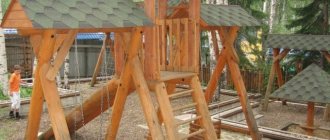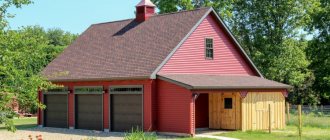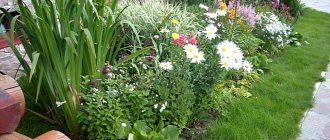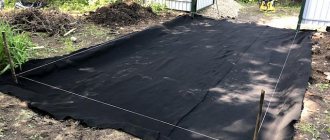The issue of parking a car in a country house, garden or suburban area, on the territory of a townhouse requires a modern functional solution. The lack of a special place for cars is fraught with rapid destruction of the soil and constant dirt on the site. The second problem is how to make parking at your dacha with your own hands, quickly, inexpensively, without resorting to the services of professionals. A modern eco-friendly solution that allows you to arrange the territory beautifully and functionally is an eco-parking lawn grid.
Types of country parking areas
Dachas, and everyone’s requirements for comfort are different, and parking a car in a dacha offers more than a dozen options. There are only seven types of coverage, as well as their combinations and the possibility of installing canopies. They differ in operational characteristics and costs. So, the covering for parking a car in a country house can be of the following types:
- Made of crushed stone or pebbles (bulk).
- Lawn or eco-parking.
- From paving slabs.
- Concrete.
While you are not sure that you want one... parking at the dacha might be simpler - Asphalt.
- Rubber tile.
- Flagstone.
- Parking grid.
The cheapest device, yet easy to use, is a car parking area made of crushed stone or pebbles. When properly installed (using geotextiles), crushed stone does not mix with the soil for many years. Even if geotextiles were not installed (this often happens), adding crushed stone is not a problem. After some time, the lower layer of crushed stone and soil becomes so dense and strong that this process (mixing with soil) stops.
Eco-parking price
The cost will depend on the following factors:
- surface area;
- base height;
- quality of material;
- soil excavation and removal (if necessary).
If you do not plan to do the work yourself, then even to calculate the material you need to invite a specialist.
If the eco-parking is done on a suburban area, then most likely the soil that will be removed can be used for lawns. They will definitely be violated, as curbs will be installed.
Parking at the dacha: pros and cons of different options
A separate and very important advantage that parking in a dacha made of crushed stone provides is natural drainage. You do not need to build drainage. Water seeps between the stones and goes into the ground, taking with it pollution. But this type of site is not suitable for areas with high groundwater levels. Standing in a puddle on rubble is not the best solution to the problem, although the problem can be solved by creating a drainage system for the entire area.
Green parking has become increasingly popular in recent years. This is not an ordinary lawn, but a special one. A plastic grid is hidden under the grass, which redistributes the load on the ground and prevents the wheels from falling through. Caring for such a parking lot is similar to caring for a lawn - mowing, watering. Weeding is not required, since the preparatory work involves removing the soil, that is, most of the roots go away. The varieties of herbs used are special, and this is the problem: they are expensive. The second disadvantage is the possibility of freezing (the seeds are expensive, and the greens do not grow too quickly). But it's beautiful. And it can be used not only as a parking lot, but also as a recreation area.
Parking grates are not plastic, but concrete with holes for grass
A platform for a car in a country house made of paving slabs is the best option for a hard surface for heaving soils. And the water does not stay for too long - it goes into the cracks between the tiles, and the integrity of the coating does not suffer during heaving. Two more options: concrete and asphalt country parking are reliable and durable, but only if all preliminary work is carried out correctly. Their disadvantage is that they are expensive, and the appearance of cracks is very noticeable.
Lawn arrangement
Here comes the last stage, which will turn the area, which is not very pleasing to the eye, into a smooth green lawn.
The cells of the laid lattice must be filled with soil and, if necessary, fertilizers applied.
This can be done in layers, and when laying the topmost layer, the soil can be mixed in advance with lawn grass seeds.
After backfilling is completed, the soil must be watered well.
For green parking, you should choose low-growing perennial grasses that can grow in low light conditions, such as:
- ryegrass ;
- fescue ;
- bluegrass
and other similar herbs.
You should not start using the parking lot immediately after sowing. Let the grass grow a little.
It will take very little time for a black parking area to turn into a soft carpet of fresh greenery.
Subsequently, in order for the lawn to continue to delight with its condition and even surface, let the grass spend time in the sun from time to time. Don't leave your car in one place for a long time.
Construction of a dacha parking area: preparatory work
Despite the different surfaces for parking a car at the dacha, the preparatory work is not much different. The difference may be in the layer on which the coating is laid (for example, you need to pour a layer of sand when paving with paving slabs), but the whole pie and the list of other works are the same.
You can do this... until you get stuck after the rain
General recommendations
The first thing you need to decide on is the location. The parking lot at the dacha is usually located either right next to the gate or not far from it. And it makes sense. But this zone should not be the lowest point, otherwise water will constantly stagnate here, and a height difference here is also undesirable - putting the car on the handbrake and putting on chocks is not exactly what you want.
The best way to compact sand and gravel is to use a plate compactor. If you don’t have one, you can make a homemade tamper. Take a log, attach handles, and attach a strong platform (thick board) to the bottom. By lifting and sharply throwing this tool, you compact the sand/crushed stone
At the same time, solid surfaces such as concrete or asphalt should not be brought to zero level: water after washing a car or rain will not drain away. To prevent it from stagnating, it will be necessary to form a slight slope - from the center to the edges. A slope of a couple of degrees is already good. And the car will stand stable, and the water will drain.
Dimensions
The dimensions of a country parking lot depend on the planned number of cars “living” there. A plot of 3*5 meters is enough for one car, i.e. 15 m². This space is quite enough to not have to think about parking exactly in the center, otherwise you will have to go out onto the lawn, into a flower bed, etc. Parking at a dacha of such an area makes it possible to calmly walk around the car in front and behind.
If space is limited, the length can be reduced by 0.5 m, but with this size you can walk either in front of the car or behind it. Only if you have a large-sized jeep, it is better to increase the width of the platform by at least 50 cm, and even better - by a meter. These machines are large and require more space.
Parking lot sizes: this picture is from SNiP (building codes and regulations)
If you need to park two cars and they are “standard” sizes, the comfortable parking length at the dacha remains the same - 5 m. If there is enough space, we take the same width as 3 meters. That is, to park two cars you will need a site measuring 5*6 m (5 meters is the length). If there is a shortage of space, the width and length can be reduced by 0.5 meters (4.5 * 5.5). But in this case, it will not be possible to open the car doors at the same time and it will also be difficult to walk around the car.
Car entry: water drainage
The next step is to decide whether you need drainage around the parking lot at your dacha or not. If the soil drains water well naturally and the surface is not continuous (tiles, lawn, stone), it is quite possible to do without drainage measures. If at least one of the conditions is absent, drainage will have to be done. There are many options, but there are three simplest ones:
- If the water on the site usually does not stagnate, the perimeter of the site with a continuous coating (concrete, asphalt, rubber tiles) is sprinkled with crushed stone 30-40 cm wide. The water drains, enters the crushed stone floor and gradually goes into the ground.
- If a drainage system is installed on the site, drainage pipes are laid around the perimeter (10 cm below the coating level, cover the top with crushed stone, pebbles, mulch, sand, plant a lawn). These pipes are inserted into the general drainage system (do not forget to make a couple of inspection hatches for cleaning.
Parking area drainage - Install/fill storm drains around the perimeter and drain them into the storm drain.
When can you not think about draining water? When you have a sandy area or heavy rainfall is rare. Then there are no problems. Another option is a natural slope. In this case, the water will flow away by gravity, but you will still be solving the problem of storm drainage, only on the scale of the entire site.
With or without border
Any covering on the site for a car in the country will last longer if the area is fenced with a curb. In the case of a gravel or pebble parking lot, the curb will not allow the filler to scatter throughout the area. In the case of using paving slabs or stone, the presence of limiters can also be considered mandatory. They are laid on a sandy layer, and the sand can be washed away by rain streams.
Curbs are desirable for aesthetic and practical reasons
This will not happen if the parking lot at the dacha is at the same level or slightly lower than the rest of the site. But in this case, it will always be humid here and the water will not drain away, which obviously will not benefit your car. So the presence of a border is desirable - at least bury a brick around the perimeter, but then natural stone would be better. Or pour the concrete yourself, but it’s less troublesome to use ready-made curbs. For a budget option, you can use reinforced concrete grape columns.
Advantages
- Environmental friendliness. The resulting platform improves the microclimate, traps dust and harmful substances.
- Aesthetics. In the courtyard of a country house or in a country house, a green parking lot will look more pleasant than a concrete or asphalt one. It pleases the eye, lifts the mood, and fits harmoniously into the natural landscape, which is very important for a suburban area.
- Economical. The construction of such a parking space on a suburban site will be simpler and cheaper than laying asphalt or concrete. Costs will be for watering, fertilizing and mowing the lawn. The gratings used for parking allow water to penetrate into the lower layers of the soil, so that water does not stagnate on the surface and puddles and dirt do not remain.
- Children can play on the playground; the green parking does not pose any danger.
Layers: general sequence
After you have selected a parking space for your car at the dacha, mark out the selected dimensions of the site (taking into account the drainage system). Next we work in this order:
- We remove a layer of soil 30-35 cm deep.
- We remove all the stones, roots, and level it (it’s not necessary to go into the horizon, but there shouldn’t be any holes or humps).
- We take a tamper and compact the soil.
Example of layers for a parking lot made of paving slabs - We spread geotextiles. Its dimensions should be 0.7-1 meters larger than the dimensions of the site, the edges should wrap around the edges of the pit for parking a car. When installing drainage, a drainage pipe is wrapped in “excess” geotextile. And so, the edges can be hidden under the grass, pressed with a border, or sprinkled with a layer of gravel.
- Pour a layer of sand, level it, tamp it down. When compacted, the layer is 10-15 cm. To make compacting easier, the sand is wetted with water.
- Add a layer of crushed stone. It is advisable to use two fractions: large and medium. A layer of coarse gravel (20-40 mm) is laid on the sand, leveled, and compacted. Its thickness is 10 cm when finished.
- A layer of medium gravel (5-20 mm). Leveled, compacted. Its thickness is also approximately 10-15 cm.
For now, an exotic option for our summer cottages is rubber coating.
In general terms, these are all the rules and features of arranging a parking lot in a country house. More precise layer sizes depend on the structure of the soil and the planned load. For example, for loose (sands and sandy loams) and unstable (peat bogs) soils, to give greater stability, a road mesh can be laid at the bottom of the pit. It will eliminate pushing.
Second example: a layer of geotextile can be laid between sand and gravel. The bottom layer (at the bottom of the pit) is necessary to stabilize the base and also to prevent plants from sprouting. Intermediate layers provide more reliable plant protection and also prevent layers from mixing. In this case, even a heavy vehicle will not leave a rut.
Selecting material for the site
Any mesh has two important parameters - the perceived load and the cell size. The parameters are interrelated and offer the buyer a wide range of different solutions. Almost all manufacturers write in the product labeling the maximum possible weight per 1 square meter. m surface. For this parameter, select a mesh, not forgetting to add a 30-40% safety factor to increase the mass due to passengers and cargo in the car. Of course, this rule only applies to parking. For a playground or lawn near the house, you can choose a reserve of 10-20%.
The lawn grate is made of a special environmentally friendly polymer. You should not choose cheap analogues made of PVC or other specialized types of plastic. Their strength will be lower, and the savings from their acquisition are not very significant.
Features of sites with different surfaces
Coarse sand or fine granite chips (1-4 mm) are poured under paving slabs, bricks, flagstones, rubber tiles. Please note that for car parking, tiles need to be at least 50 mm (for paths, you can take from 30 mm). One more point: the smaller the size of the tiles used to pave the parking lot at the dacha, the less noticeable will be the inevitable “game” of the levels of the bricks.
Different coatings for summer cottage parking lots have their own installation characteristics.
Natural stone and concrete slabs
If you decide to make a parking lot from natural stone cut into slabs, it should also be 4-5 cm thick. You should not lay too large pieces: there is a high probability that they will break. They should not be placed closely, but leaving gaps of a couple of millimeters. The gaps are filled with sand, to which you can add abrasion-resistant lawn grass seeds. If you make the same paths, it will turn out beautifully, organically, and there will be no dirt.
With natural stone everything looks very decent
If the grass doesn’t appeal to you (it’s more difficult to clean, you have to cut it somehow), fill the gaps between the slabs with a mixture of sand and cement (1 part cement, 3 parts sand). Sweep it off the stones so that there is nothing on them and water the area (not with a stream, but with small drops, and so that it does not flow). The mixture will turn into concrete. It will take a certain amount of time to gain strength: 7 days at a temperature of +20°C to achieve 50% strength and another two weeks for complete “ripening”. Until the strength reaches 50%, it is advisable that there are no rainfalls during this period, and if they start, cover the area with polyethylene. Water itself is not scary, but streams that can wash away fragile concrete are scary.
This option has only one drawback: the high price of the stone. To reduce costs, you can use ready-made paving slabs in large format: 50*50 cm or so. They are also laid on a gravel-sand bed. Everything is the same, only the slabs are of artificial origin and have a clear geometry.
Concrete
For a concrete site, you will need to install formwork around the perimeter. Then you will need to make a reinforcing frame in the form of a cage from a metal rod. A rod with a diameter of 10-15 mm is taken, a lattice is folded from it in increments of 10-15 cm, and tied at the joints with a special wire (knitting). The resulting mesh is placed on stops so that it is raised above the compacted crushed stone by 3-5 cm, and the layer of concrete on top should also be at least 10 cm (preferably 15).
If a concrete parking lot at a dacha is made for two or more cars, expansion joints will be required. To do this, wooden planks 0.7-1 cm thick are laid edgewise on a grid of reinforcement. The width of the planks is equal to the height of the concrete layer (they can be used as guides when leveling the concrete mixture). They are laid in increments of 2 meters.
Concrete parking for a car at the dacha in the process of being manufactured
In the case of concrete, you will have to wait quite a long time for your parking lot to start using. The concrete must stand for at least 28 days. And this is if the temperature does not drop below +20°C. At the same time, you need to ensure that the surface does not dry out. To do this, you need to water the area, and to prevent the water from drying out quickly, throw matting, old bags, etc. on top, throw a piece of polyethylene on top. This coating helps maintain humidity, equalizes temperature (local overheating is harmful) and protects the surface from drops that are inevitable when watering.
If you can’t wait that long, add an “accelerator” to the concrete. An additive that accelerates the hardening of concrete. The period may be reduced to 7-10 days. But carefully read the features of caring for such concrete.
Green lawn parking
When constructing a green parking lot, special grates are placed on a layer of gravel, the gaps of which are filled with fertile soil and sown with grass seeds. To park a passenger car, and sometimes even a jeep, a grate with a height of 10 cm is sufficient. If heavy vehicles (trucks with materials) are to be placed on the site for unloading, a grate is needed with a height of at least 15 cm.
The difference in the cost of gratings for green parking is significant. But the difference in price is usually justified: some eco-parking lots do not sag and look normal, while others crumple, turning the surface into a mess of soil and grass. Therefore, when choosing gratings, do not go for cheapness.
Lawn parking for cars at the dacha
Taking care of a grass parking lot is not very convenient: the rake gets stuck in the grate, and not every lawn mower can operate safely. Therefore, many owners of such sites are disappointed. But recently, another trend has appeared - instead of soil and grass, medium crushed stone is poured into the grates, and the top is covered with small crushed stone or pebbles. How is this option better than a regular bulk site? The platform is not pressed under the wheels of even a heavily loaded vehicle. This option is ideal for clay soils.
Installation of lawn grating
Depending on which grille is chosen, the methods of its installation also differ.
Modular plastic gratings are laid on the prepared surface, fastening them together using locks located around the perimeter.
The fastening system provides for the assembly of modules in a staggered manner, which increases the strength of the structure.
When installing volumetric polymer gratings, the longitudinal side of the strip must be secured in the ground using anchors in increments of approximately 1 m. Next, the grating is stretched to the desired size and also fixed with anchors.
In the same way, the next strip is laid nearby. The strips of the three-dimensional polymer lattice are connected to each other with special snap locks.
Note! When laying, lawn gratings must completely cover the entire area of the future parking lot.
Economy check-in and parking options
Although parking at a dacha made of crushed stone is considered the most inexpensive, its total cost is considerable. If it is not possible to invest the appropriate amount or the visit will be temporary, you can try to get by with more modest options.
The cheapest way is from old sleepers. You can find decommissioned sleepers if you wish, and they ask for very little. Since they are already impregnated with everything possible from rotting, they can be laid directly into the ground. But in order to prevent them from sticking out during heaving, it is better to dig a trench and lay at least 5 cm of crushed stone or construction waste at the bottom. It is also advisable to fill the sides of the sleepers with at least 5 cm of crushed stone.
Budget trip to the dacha for a car
One sleeper is not enough for a race (unless you are a super driver), but two per wheel is quite enough. The option is, of course, temporary, but it is more than suitable for the period of arrangement of the territory.
There is a similar idea in a more civilized version: take concrete paving slabs measuring 50*50 cm or 60*60 cm. Lay them out in two parallel rows - under the wheels. You shouldn’t press them one against the other - it’s better to leave a gap in the soil. To avoid bulging during heaving on clay soils, as in the previous option, make at least a minimal backfill of crushed stone.
Lay the slabs in a row
There are also paved country driveways. Brick and natural stone are used for paving. These options are good if the soil is not clay. The brick will collapse the fastest - it is not intended for such conditions, but as a temporary improvement measure it will do just fine.
Parking for cars from what is at hand
Vegetable garden, garden, balcony
Arranging a parking lot on a special reinforced lawn is a real way to preserve the aesthetic appearance of the site and at the same time provide a place to park a car. Let's talk about how you can make an eco-parking with your own hands, about the advantages and disadvantages of this method of arranging a parking lot.
An ordinary lawn, of course, will not withstand the constant load of a standing car. It is easily trampled and loses its attractive appearance. Therefore, special lawn gratings are mandatory for arranging eco-parking areas.
They come in two types:
• made of durable frost-resistant plastic, usually green, black or brown;
• concrete, with wider module walls.
Plastic lawn gratings are more popular today - they are easier to install, lighter, and manufacturers guarantee a service life of up to 20 years without much maintenance. The shape of module cells can be different - honeycombs, rhombuses, squares, rectangles. The individual grid plates are connected to each other with special latches, creating a complete base that evenly distributes the load in the form of passing people and vehicles.
For a house area where only cars will be parked, a lawn grid 40–50 mm high is sufficient. This coating can withstand loads from 1.2 to 4 t/m2. Reinforced grilles with additional stiffening ribs are used only where parking for heavy cargo vehicles is needed.
The objectives of the lawn lattice are:
• ensuring the levelness of the entire site;
• preservation of green cover by protecting the grass root system;
• strengthening the soil, preventing its erosion and the appearance of excavations;
• creating stable moisture circulation in the area, preventing the appearance of puddles and flood phenomena.
The lattice allows moisture to enter the soil from above, and the growing lawn from below, which is protected from external influences. In general, each cell of a concrete or plastic lattice turns out to be a small plant pot.
The process of creating an eco-parking includes the following stages:
• cleaning the area, leveling it. There should be no construction debris, plant roots, stumps on the site - nothing that could interfere with making the site level;
• laying a drainage layer. Some manufacturers claim that lawn gratings can be laid directly on leveled ground. However, in order to definitely prevent the formation of puddles, ensure normal water circulation and extend the life of the coating, you should create a drainage layer. Geotextiles, sand, and crushed stone are used. The drainage layer is compacted;
• laying lawn grating. Plastic cells snap into place, connecting to each other, concrete cells are simply laid in even rows;
• a layer of fertile soil is poured on top, the excess of which is removed, all cells must be densely filled with soil;
• the lawn is sown, watered and within a few days green sprouts will appear.
As you can see, the process of creating an eco-parking is not too complicated, it is similar to arranging garden paths and laying paving slabs.
Advantages of lawn gratings:
• protect plants from trampling, and the soil from erosion and spreading;
• the density of grass coverage can reach 90% for plastic models with thin walled modules, less for concrete ones, but the lawn will still dominate;
How to make a parking lot
First of all, you need to decide on the size of the parking lot and make preliminary markings on the ground.
Approximately, this is a rectangle, the length of which is 4.3-4.5 meters and the width of 2.5 meters. In this rectangle you need to remove the top layer of soil, about 10-20 cm. The resulting area needs to be covered with a layer of crushed stone and compacted thoroughly. The next step in the work will be laying the border or decorative stone. If you are not going to spend money on such material, then you can use a regular whole brick. Thanks to it, the boundaries of the parking lot will be marked and will prevent soil from being washed away if the parking lot is located on a slope. decorative stone is used , it will also serve as an excellent decorative element.











